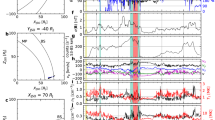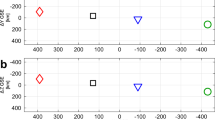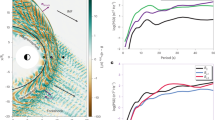Abstract
An overshoot in the magnitude of the magnetic field is shown here to be a consistent feature of supercritical collisionless shocks, Mach number ≳3, throughout the Solar System. Although the variability of the solar wind at 1 AU allows us to study the Earth's bow shock over a wide range of β, the ratio of thermal pressure to magnetic pressure, the Mach number of the solar wind at 1 AU varies over a relatively narrow range. Data from Jupiter and Saturn allow us to study the bow shock at high Mach numbers rarely, if ever, observed at Earth. These combined planetary data show that the planetary bow shocks, at least as characterized by their overshoots, form part of a continuum, differences being dependent mainly on the varying solar wind conditions at each of the planets. The overshoot magnitude is found to increase both with β and magnetosonic Mach number. However, it is the radial variation of Mach number which causes the overshoot in the jovian and saturnian bow shocks to be much greater than in the terrestrial shock.
This is a preview of subscription content, access via your institution
Access options
Subscribe to this journal
Receive 51 print issues and online access
$199.00 per year
only $3.90 per issue
Buy this article
- Purchase on SpringerLink
- Instant access to full article PDF
Prices may be subject to local taxes which are calculated during checkout
Similar content being viewed by others
References
Sonnerup, B. U. O. J. geophys. Res. 74, 1301 (1969).
Tidman, D. A. & Krall, N. A. Shock Waves in Collisionless Plasmas (Wiley, New York, 1971).
Heppner, J. P., Sugiura, M., Skillman, T. L., Ledley, B. G. & Campbell, M. J. geophys. Res. 72, 5417 (1967).
Russell, C. T. & Greenstadt, E. W. Space Sci. Rev. 23, 3 (1979).
Bame, S. J. et al. Space Sci. Rev. 23, 75 (1979).
Leroy, M. M., Goodrich, C. G., Winske, D., Wu, C. S. & Papadopoulos, K. Geophys. Res. Lett. 8, 1269 (1981).
Scarf, F. L., Gurnett, D. A. & Kurth, W. S. Nature 292, 747–750 (1981).
Russell, C. T. IEEE Trans. Geosci. Electron. GE–16, 239 (1978).
Russell, C. T., Snare, R. C., Means, J. D. & Elphic, R. C. IEEE Trans. Geosci. Remote Sensing GE–18, 32 (1980).
Russell, C. T., Elphic, R. C. & Slavin, J. A. Nature 282, 815 (1979).
Smith, E. J. et al. J. geophys. Res. 85, 5655 (1980).
Author information
Authors and Affiliations
Rights and permissions
About this article
Cite this article
Russell, C., Hoppe, M. & Livesey, W. Overshoots in planetary bow shocks. Nature 296, 45–48 (1982). https://doi.org/10.1038/296045a0
Received:
Accepted:
Issue date:
DOI: https://doi.org/10.1038/296045a0
This article is cited by
-
Magnetosheath jets at Jupiter and across the solar system
Nature Communications (2024)
-
Occurrence rate of ultra-low frequency waves in the foreshock of Mercury increases with heliocentric distance
Nature Communications (2021)
-
Magnetohydrodynamic Shocks in the Interplanetary Space: a Theoretical Review
Brazilian Journal of Physics (2017)
-
Shocks in collisionless plasmas
Reviews of Modern Plasma Physics (2017)
-
Solar Wind and Internally Driven Dynamics: Influences on Magnetodiscs and Auroral Responses
Space Science Reviews (2015)



